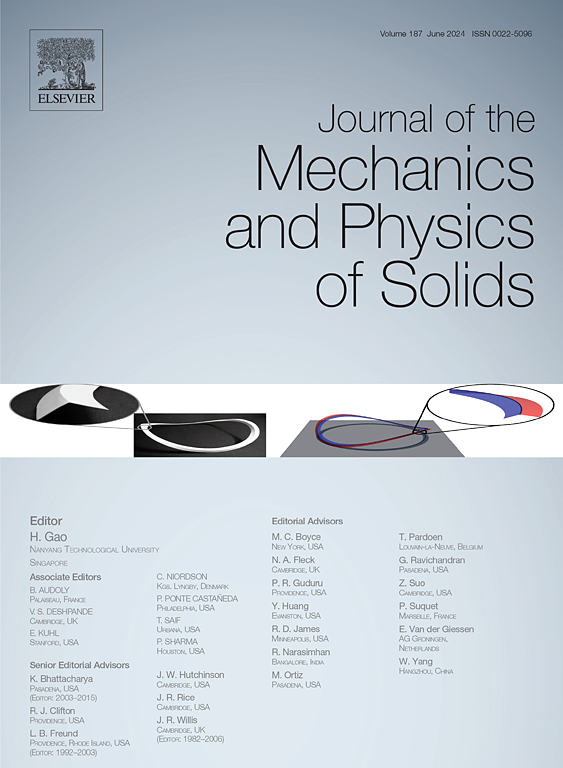Stress singularities in the generalised Comninou frictional contact model for interface cracks in anisotropic bimaterials
IF 6
2区 工程技术
Q2 MATERIALS SCIENCE, MULTIDISCIPLINARY
引用次数: 0
Abstract
Characterisation of the singular asymptotic solution at the tip of interface cracks between dissimilar materials is essential for assessing the structural integrity of heterogeneous material systems. In the present article, the Comninou contact model, one of the most relevant and widely used models, originally introduced for isotropic bimaterials, is generalised for the first time to any anisotropic linear elastic bimaterial under generalised plane strain, considering a frictional sliding contact zone adjacent to the crack tip. The classical Coulomb friction law is considered. A novel procedure, based on the Stroh formalism of linear anisotropic elasticity, is developed to derive a system of two new coupled nonlinear eigenequations given in closed form for two unknown parameters of such singular solutions, the singularity exponent and the sliding angle in the contact zone. In general, this eigensystem is solved by an iterative method, although in some cases, closed-form solutions are provided. Parametric studies of the influence of material orientations and the friction coefficient value on variations of and reveal several surprising features of this asymptotic solution. The present approach is successfully verified by comparing some of the results obtained with those reported in previous studies, wherever possible. Note that previous studies essentially focused on bimaterials with specific orientations, considerably simplifying the problem. The singular solutions obtained can also be used in the asymptotic analysis of elastic fields at the boundary between stick and slip zones in partial slip contact problems for anisotropic materials.

各向异性材料界面裂纹广义cominou摩擦接触模型中的应力奇异性
异种材料界面裂纹尖端奇异渐近解的表征对于评价非均质材料体系的结构完整性至关重要。在本文中,Comninou接触模型是最相关和最广泛使用的模型之一,最初是为各向同性双材料引入的,首次推广到广义平面应变下的任何各向异性线弹性双材料,考虑了裂纹尖端附近的摩擦滑动接触区。考虑了经典的库仑摩擦定律。基于线性各向异性弹性力学的Stroh形式,导出了一个由两个新的耦合非线性特征方程组成的系统,该系统以闭合形式给出了奇异解的两个未知参数,即奇异指数λ和接触区滑动角ω。一般来说,这个特征系统是用迭代法求解的,尽管在某些情况下,也提供了封闭形式的解。材料取向和摩擦系数值对λ和ω变化的影响的参数化研究揭示了该渐近解的几个惊人特征。通过尽可能将所获得的一些结果与以前研究报告的结果进行比较,成功地验证了本方法。请注意,以前的研究基本上集中在具有特定方向的双材料上,这大大简化了问题。所得奇异解也可用于各向异性材料部分滑移接触问题粘滑区边界弹性场的渐近分析。
本文章由计算机程序翻译,如有差异,请以英文原文为准。
求助全文
约1分钟内获得全文
求助全文
来源期刊
CiteScore
9.80
自引率
9.40%
发文量
276
审稿时长
52 days
期刊介绍:
The aim of Journal of The Mechanics and Physics of Solids is to publish research of the highest quality and of lasting significance on the mechanics of solids. The scope is broad, from fundamental concepts in mechanics to the analysis of novel phenomena and applications. Solids are interpreted broadly to include both hard and soft materials as well as natural and synthetic structures. The approach can be theoretical, experimental or computational.This research activity sits within engineering science and the allied areas of applied mathematics, materials science, bio-mechanics, applied physics, and geophysics.
The Journal was founded in 1952 by Rodney Hill, who was its Editor-in-Chief until 1968. The topics of interest to the Journal evolve with developments in the subject but its basic ethos remains the same: to publish research of the highest quality relating to the mechanics of solids. Thus, emphasis is placed on the development of fundamental concepts of mechanics and novel applications of these concepts based on theoretical, experimental or computational approaches, drawing upon the various branches of engineering science and the allied areas within applied mathematics, materials science, structural engineering, applied physics, and geophysics.
The main purpose of the Journal is to foster scientific understanding of the processes of deformation and mechanical failure of all solid materials, both technological and natural, and the connections between these processes and their underlying physical mechanisms. In this sense, the content of the Journal should reflect the current state of the discipline in analysis, experimental observation, and numerical simulation. In the interest of achieving this goal, authors are encouraged to consider the significance of their contributions for the field of mechanics and the implications of their results, in addition to describing the details of their work.

 求助内容:
求助内容: 应助结果提醒方式:
应助结果提醒方式:


